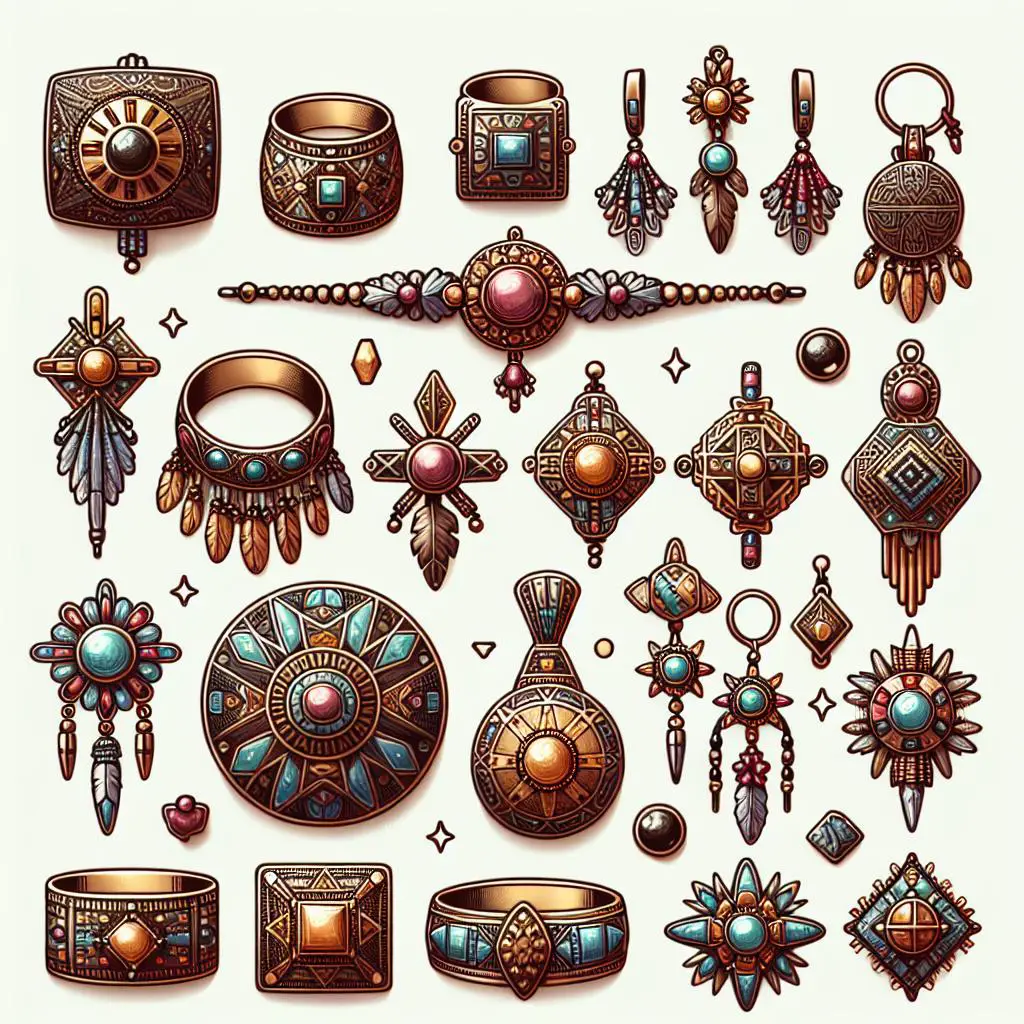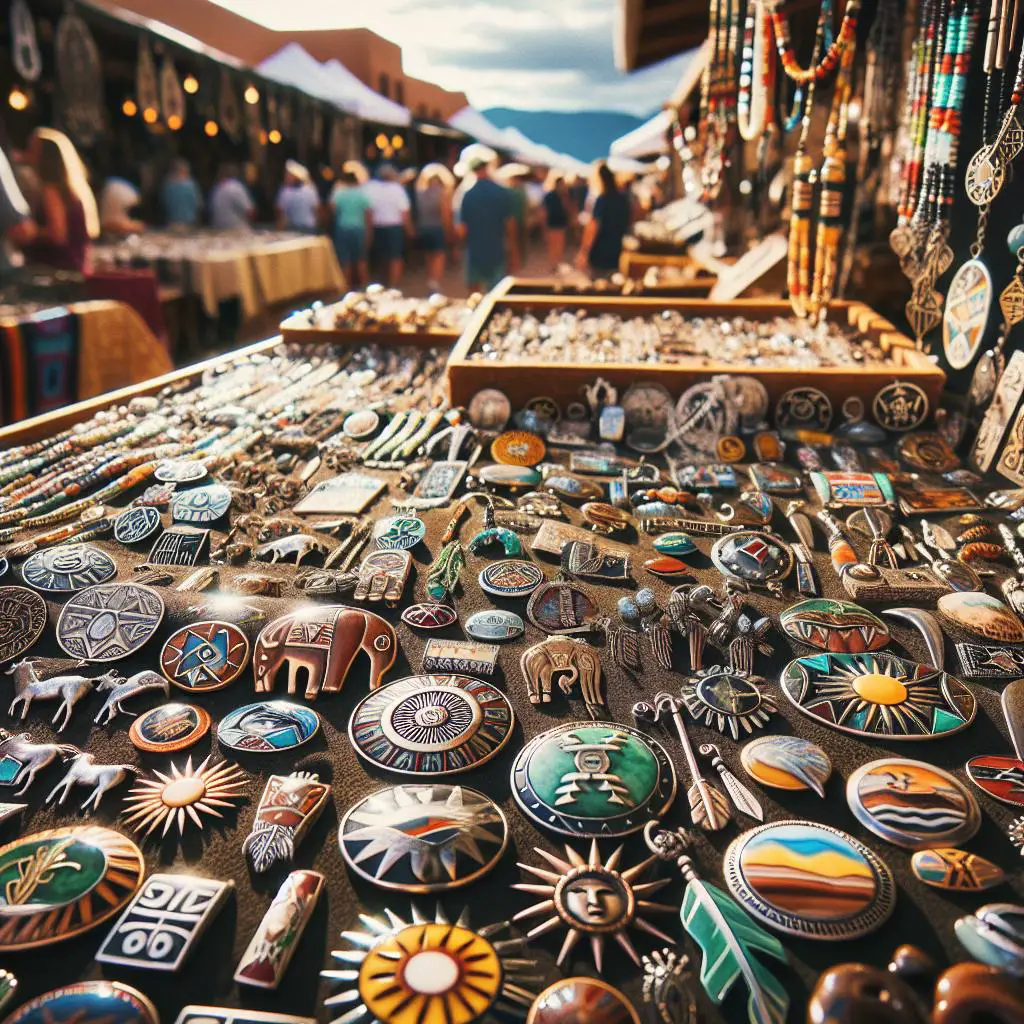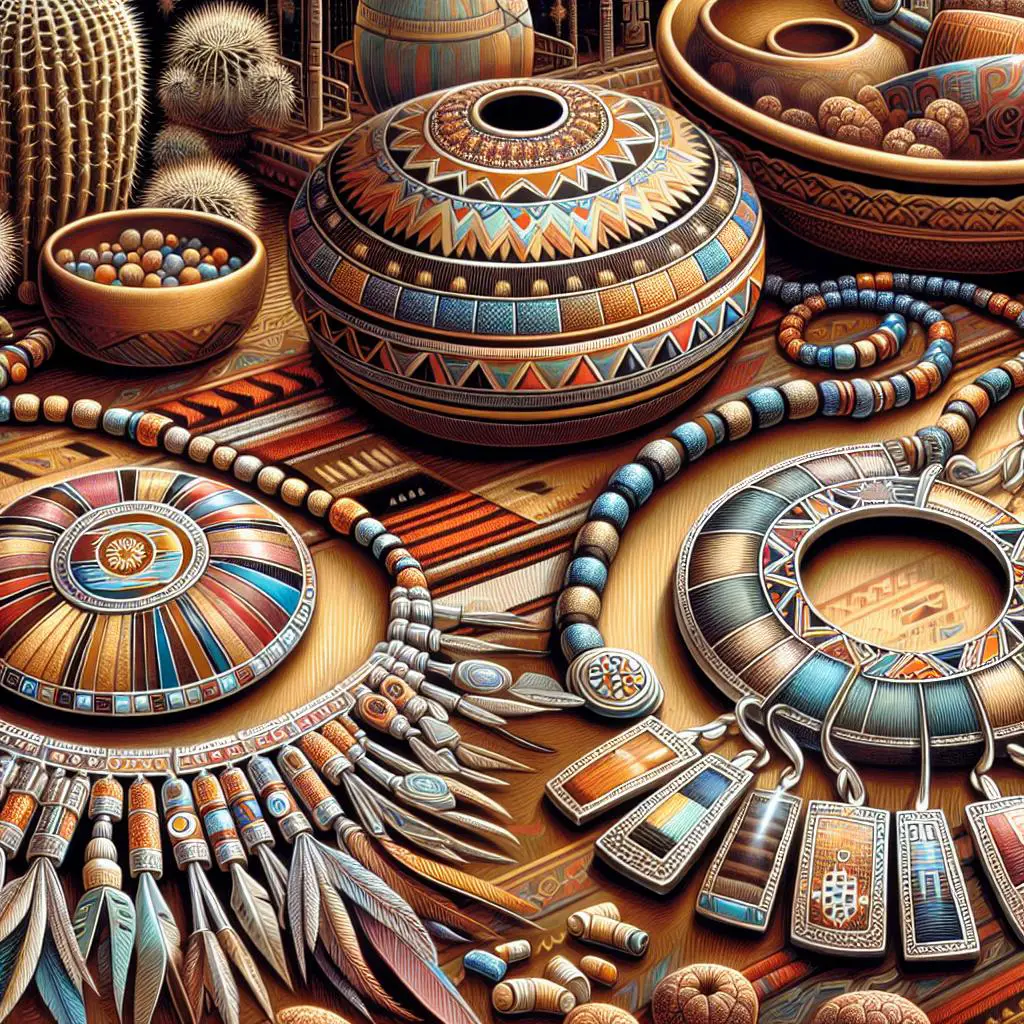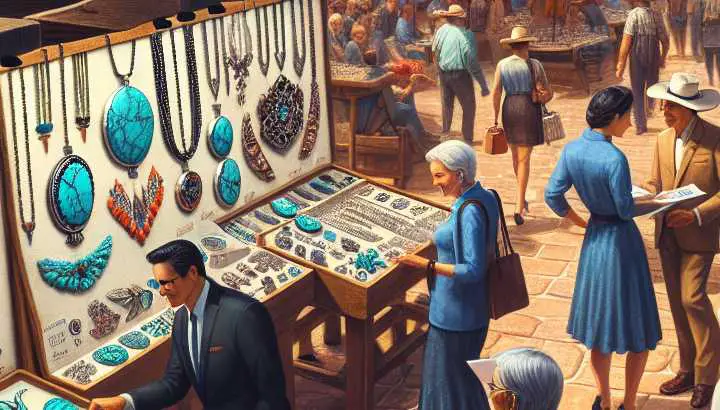The Symbolism in Southwestern Jewelry

1. Use of sacred symbols in Southwestern jewelry
Title: Sacred Symbols and Southwestern Jewelry: A Tale of Spiritual Bling
Once upon a time, in the arid landscapes of the southwestern United States, nestled between charismatic cacti and sunburned sandstones (apparently, even stones can get a little flushed!), a unique and highly significant art form took root. Yes ladies and gents, we are talking about Southwestern jewelry. Far from being merely dramatic baubles or superficial adornments, these pieces are brimming with sacred symbols and spiritual significance.
Imagine you are strutting around town with a chic Southwestern necklace, making heads turn every now and then. As you flash a smug smile, are you aware that the tantalizing turquoise pendant hanging around your neck isn’t just a sparkly accessory? It’s also a throbbing emblem of wisdom, protection, and a symbol of successful love. Now, isn’t that much more than just a Monday major show-off piece?
Let’s migrate to the world of Hopi and Navajo tribes, from where this jewelry got its zing. Brace yourself, as we delve into the deep, mystical realms of Southwestern jewelry and its sacred symbols, where every trinket tells a tale, and every bauble bewitches with a backstory.
First up on our spiritual runway is the iconic Kokopelli symbol, known often as the hunched-back flute player. No, he isn’t suffering from bad posture! In the Southwest native culture, Kokopelli symbolizes the spirit of music, fertility, and the mischievous trickster. Sporting a jewelry piece with this symbol would make you an instant hit at a family reunion (wink).
Next, we have the stoic Bear. In Southwestern cultures, the bear symbol represents strength and power to endure. Seriously, who wouldn’t want an elegant emblem of the most hardcore hibernator around their neck or on their finger? It’s a symbolic win-win!
Turning corners, we find ourselves face-to-face with the beautiful Butterfly – now don’t flutter away in excitement! Known for its fun and flirty vibe, in these cultures, the butterfly symbolizes transformation and renewal.
“Now the names of the nomes and the symbols or emblems by which they were distinguished are of very great interest in this connection”
~ L.W., History Of Egypt, Chaldea, Syria, Babylonia, And Assyria In The Light Of Recent Discovery
Who knew mere dangly earrings could have such a profound impact?
Can’t forget the spiraling Swirl or whirling Wind symbol, an emblem of personal power, independence, and non-conformity. It’s a favorite ornament among the anti-mainstream vanguards, individualist misfits, and rabble-rousing rebels. If you love coloring outside the lines, this symbol on your jewelry will be the perfect accessory to your artistic angst.
Finally, swooping in is the majestic Eagle. This bird represents a connection to the divine, courage, and spiritual protection. An eagle jewelry piece may not give you wings, but it sure as heck will make you feel you’re soaring!
In a nutshell, each motif rendered in Southwestern jewelry isn’t just eye-candy, it’s a spiritual whisper, echoing with centuries-old wisdom and indigenous storytelling. Talk about an accessory power-up – it’s no longer just about managing a fashion statement but also revealing a scope of spiritual vivacity. So, next time you spot a Southwestern jewelry piece, don’t just admire its sparkle, mull over the symbolic saga it brings with it. Remember, in Southwestern jewelry, you’re not just wearing bling, you’re wearing a kaleidoscope of culture, cosmic wisdom, and sacred soulfulness. Now that’s what we call haute couture with a spiritual twist!
Learn More Here: 1. Use Of Sacred Symbols In Southwestern Jewelry

2. Role of nature in Southwestern jewelry symbolism
If you’ve ever cast your eye over a finely crafted piece of Southwestern jewelry, you might have been so dazzled by the glimmering turquoise, the scintillating silver, or the enigmatic etchings that you didn’t even stop to think about the symbolism wrapped within. That’s right, folks, beneath that irresistible bling, there are deep meanings and traditional associations as thrilling as a wild, moonlit ride through the desert. And most of these symbols tap-dance their merry jig back to nature.
So, hop on your spectral stallion and let’s take a luminous ride along the interwoven threads of culture, nature, and jewelry in the heart-stirring Southwestern style.
Imagine the Southwestern landscape. Are you picturing dusty plains stretching out to distant mountains, coyotes crooning beneath a scimitar moon, and dry-baked earth silently praying for rain? If so, well done. If not, you might have to reconsider your cinematic desert references; clearly, they’ve led you astray.
Jokes aside, it is this breathtakingly stark, yet mesmerizingly beautiful landscape that suffuses Southwestern jewelry with its unique meaning. The jewelry designs often mirror the geographical features and natural elements seen within this wondrous panorama. Essentially, elements of nature are adjustable metaphors carried with pride and elegance. No, you won’t have to wear a tiny cactus around your neck, don’t worry.
Take, for example, the well-loved turquoise. This luminescent gem held a high place in Southwestern cultures for its symbolism. The Hopi and Pueblo people believed it was a piece of the sky that had fallen to Earth. It was thought to offer protection, symbolize water, sky, bountiful harvests, and even ward off evil spirits. Quite an impressive CV, right?
Animals feature heavily too. Birds, reptiles, and mammals found in the region often become encapsulated within these shiny charms.
“Young, handsome, of a frank and generous nature, he yet lacked the gifts that charm women; or at least this one woman was cold to him”
~ M. E. Braddon, London Pride, Or, When the World Was Younger
Ever wanted to channel your inner spirit animal? Well, who needs a psychologist when you can proudly flaunt your armadillo brooch?
The bear, in particular, is an iconic symbol deeply associated with strength, wisdom, and healing. Many jewelry pieces incorporate the bear or bear claw design, enabling the wearer to make a statement that’s bolder than a bear wrestling a buffalo. Meanwhile, the hummingbird, with its tireless energy and delicate grace, symbolizes love and beauty. Donning a hummingbird necklace might not enable you to hover mid-air, but it’ll darn sure make you feel light on your feet.
Not to forget the fascinating patterns of twisting spirals, thought to represent life’s journey. So, if you’re drawn to these patterns, it’s likely not due to your latent hypnotist tendencies but rather a celebration of the mystical twists and turns of life.
Compare this to the Zia, impressively doing quadruple duty by symbolizing the sun, the four directions, the four seasons, and the four stages of life (childhood, youth, adulthood, and old age). To think, all this has been hiding within the four discreet lines on your beaded bracelet!
Now you can feel a deeper appreciation for the richness of Southwestern jewelry. It’s not just there to make you look like a bedazzled desperado. Each piece tells a story, reverberates a harmony between nature and culture, and allows you to carry a bit of the Southwestern spirit wherever you go. Ultimately, every pendant, earring, or bracelet is an opportunity to screamingly whisper something about your connection to the natural world, cultural roots, and individual journey.
So next time you admire that gleaming turquoise ring or that charming hummingbird pendant, remember you’re not just donning a piece of jewelry. You are wearing a fragment of ancient wisdom, cultural legacy, and natural symbolism. You’re wearing a piece of the Southwest’s stunningly beautiful soul. And you look darn good doing it!
Read More: 2. Role Of Nature In Southwestern Jewelry Symbolism

3. Cultural meanings behind southwestern jewelry materials
Title: “Three Strikes of Cultural Coolness: The Mad Marvels of Southwestern Jewelry Materials!”
Yee-haw, everybody! Saddle up and adjust your hat brims as we embark on a jaunty journey into the heart of the desert. Or should we say, the hearth of culture – an adventure into the history, metaphoric symbolism, and good ‘ol enchantment of Southwestern jewelry materials. In this crafty corner of the United States, the stories alive in each nugget of turquoise, strand of silver, and hunk of coral connect closely to the core of Indigenous cultures, whispering tales of history, and gasping for breath in the face of exceptional beauty.
1. Turning Blue with Envy over Turquoise
Turquoise might just be the heartthrobs of Southwest jewelry, stealing glances and hearts with its alluring shades ranging from cerulean heaven to robin’s-egg-spotted-with-clouds. As the saying goes, “When you’ve got it, flaunt it.”
Southwestern tribes, like the Navajo, Hopi, and Zuni, have long appreciated turquoise not just for its striking beauty but also its deep cultural significance. Considering them pieces of sky brought down to Earth, turquoise were hoarded like the bobby socks at an Elvis concert. They symbolized protection, good fortune, and spiritual connection.
Also, it was believed to be the stone of truth and integrity. So, if you witness your friend mightily clutching his turquoise necklace while swearing he didn’t eat your last tacos, chances are – he did. Or perhaps, he’s just fashion-forward?
2. The Silvery Threads of Storytelling
Next on the runway of cultural allure is silver. Or should we say, the “Bentley” of Southwestern jewelry? It’s flashy, it’s classy, and if you’ve got a piece on, you’re pretty much the bell of that Arizona ball.
Long before the hype of Tiffany or Cartier, Native American tribes had already worked silver into their cultural fabric.
“In these upper strata of the mound are found remains of the Arab, Sassanian, Parthian, Seleucian, and Persian periods, mixed indiscriminately with one another and with Elamite objects and materials of all ages, from that of the earliest patesis down to that of the Susian kings of the seventh century B.C”
~ L.W., History Of Egypt, Chaldea, Syria, Babylonia, And Assyria In The Light Of Recent Discovery
Silver provides a canvas for showing off the craftsmanship skill of the artists, with every swirl, stamp and a claw holding a piece of turquoise revealing a narrative unto itself.
For the Navajos, silver represented purity and clarity. For the Hopi, those shiny motifs on clan symbols told ancestral stories. Plus, during a hot Southwestern Day, a shiny silver piece might just give you the edge in signaling for more beer at barbeques – multi-functional, we say!
3. The Burning Beauty of Coral
Last on the list – but definitely not least – is coral, the under-appreciated superhero of Southwest gemstones. Shaded with hues from the spectacular sunset red to soft pink, corals have historically warmed their way into Southwestern heartlands.
Once more popular than turquoise and considered beyond valuable by tribes like the Navajo, these fiery ocean critters are associated with the life force, familial continuity, and transformation, primarily due to their sea-to-stone journey.
Seriously, if coral were a movie character, it’d be the phoenix soaring courageously across the screen amidst a blazing sea of fire. Darn, that would make some rad jewelry!
Whew, how was that for a rodeo? Now quieter down, partners! The next time you lay your peepers on some fantastic Southwestern jewelry, remember – you ain’t just looking at stylish fashion statements. You’re gazing upon a tapestry of cultural stories and histories, woven into the very materials of those exquisite pieces.
Now, if you’ll excuse me, I’ve got to find another taco – and perhaps a turquoise necklace for a friend!
Source: 3. Cultural Meanings Behind Southwestern Jewelry Materials
